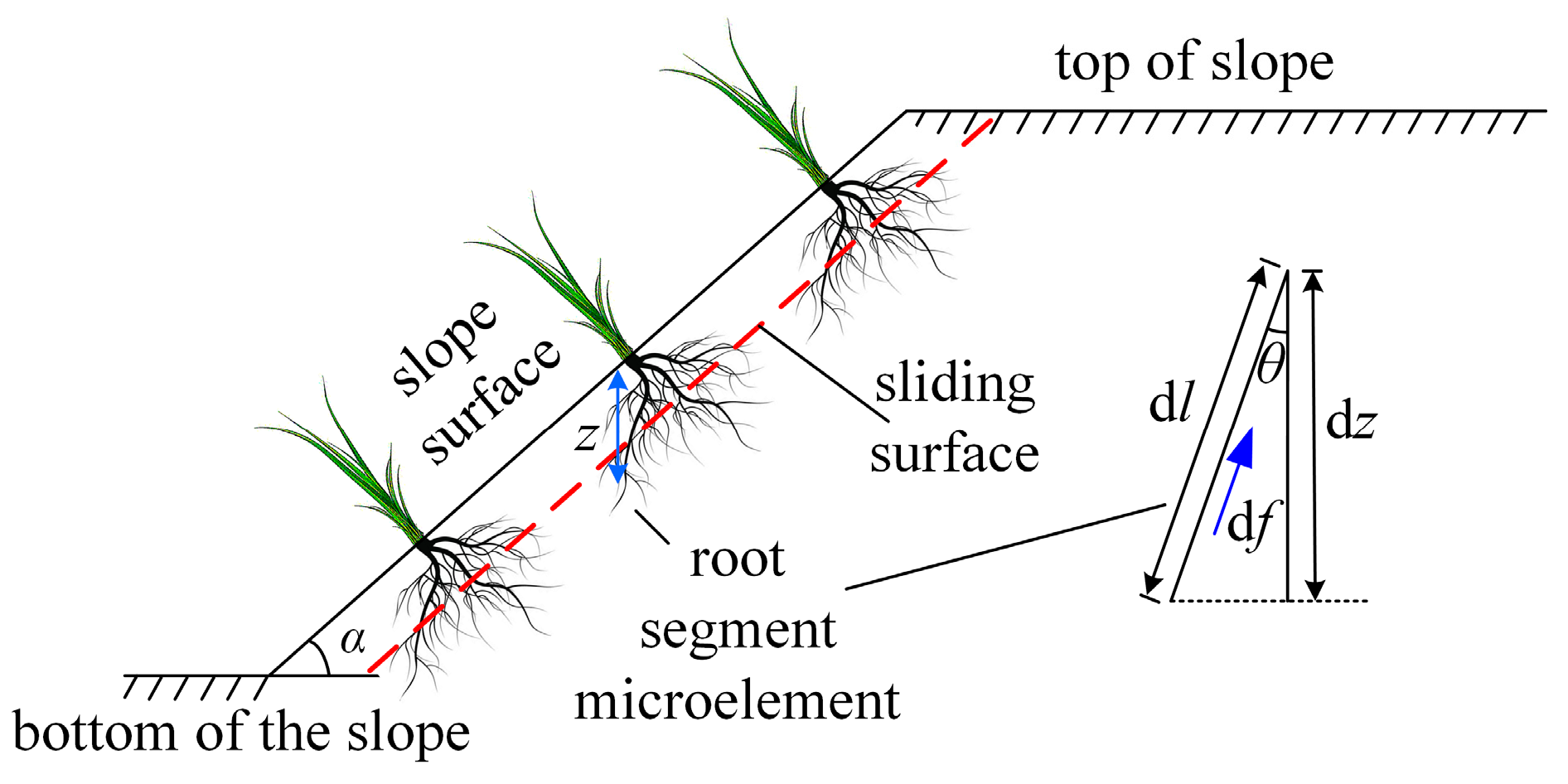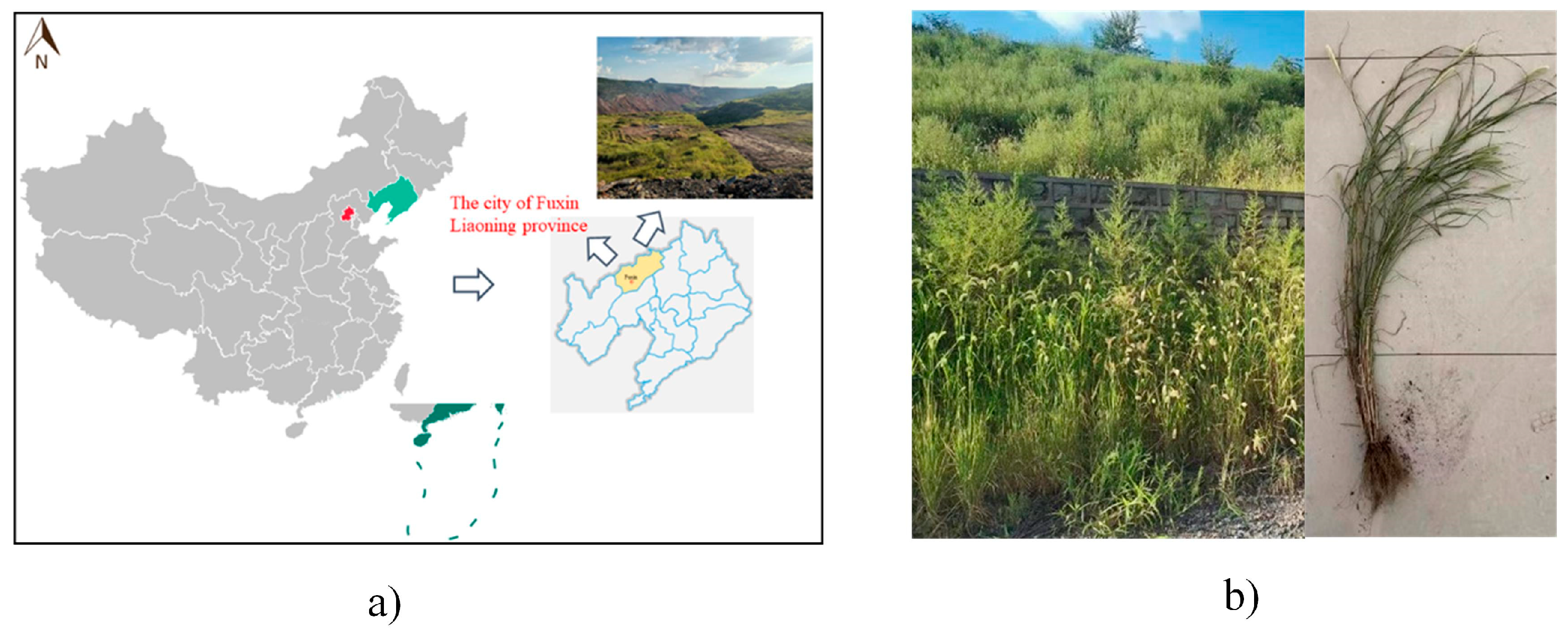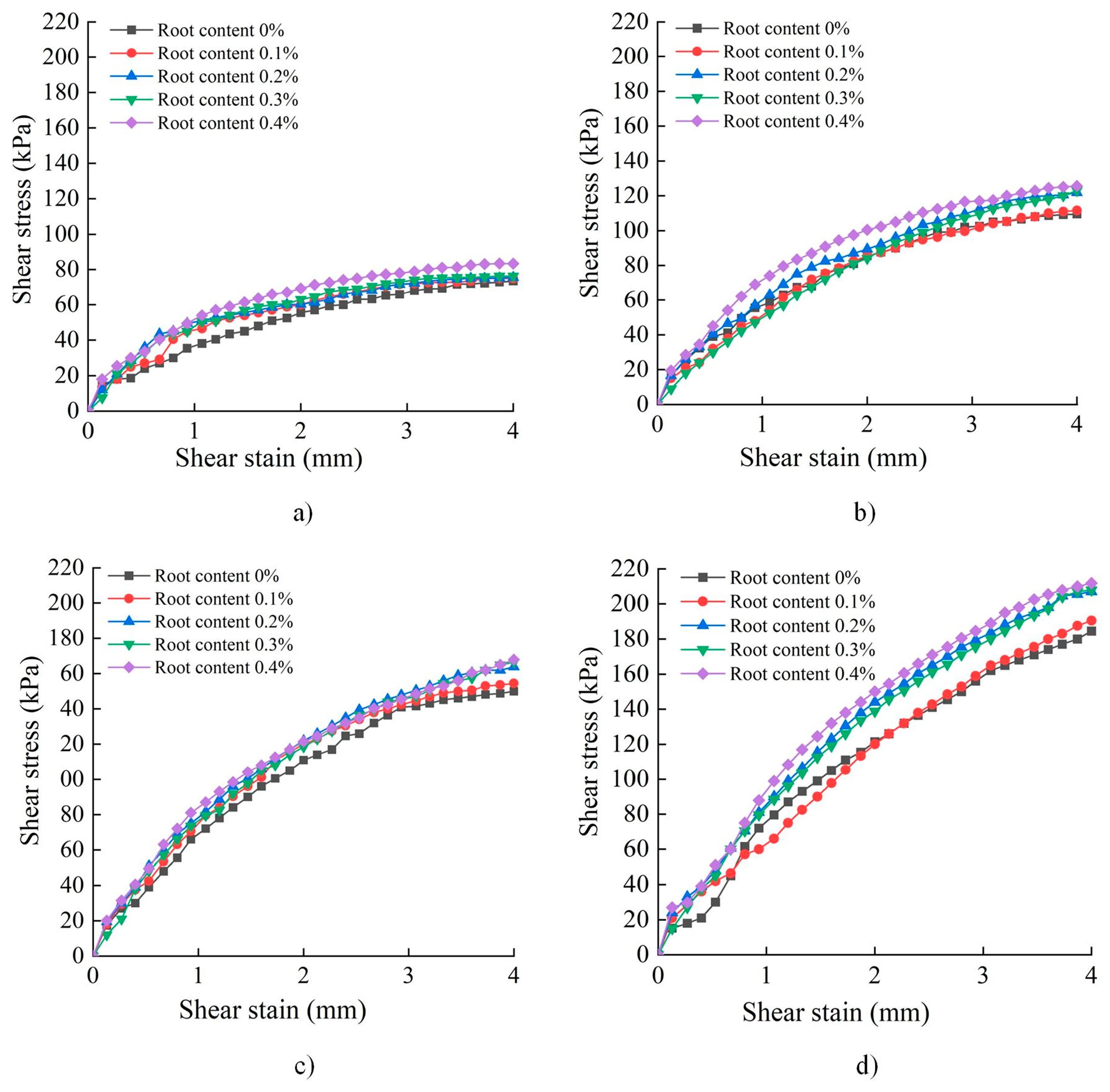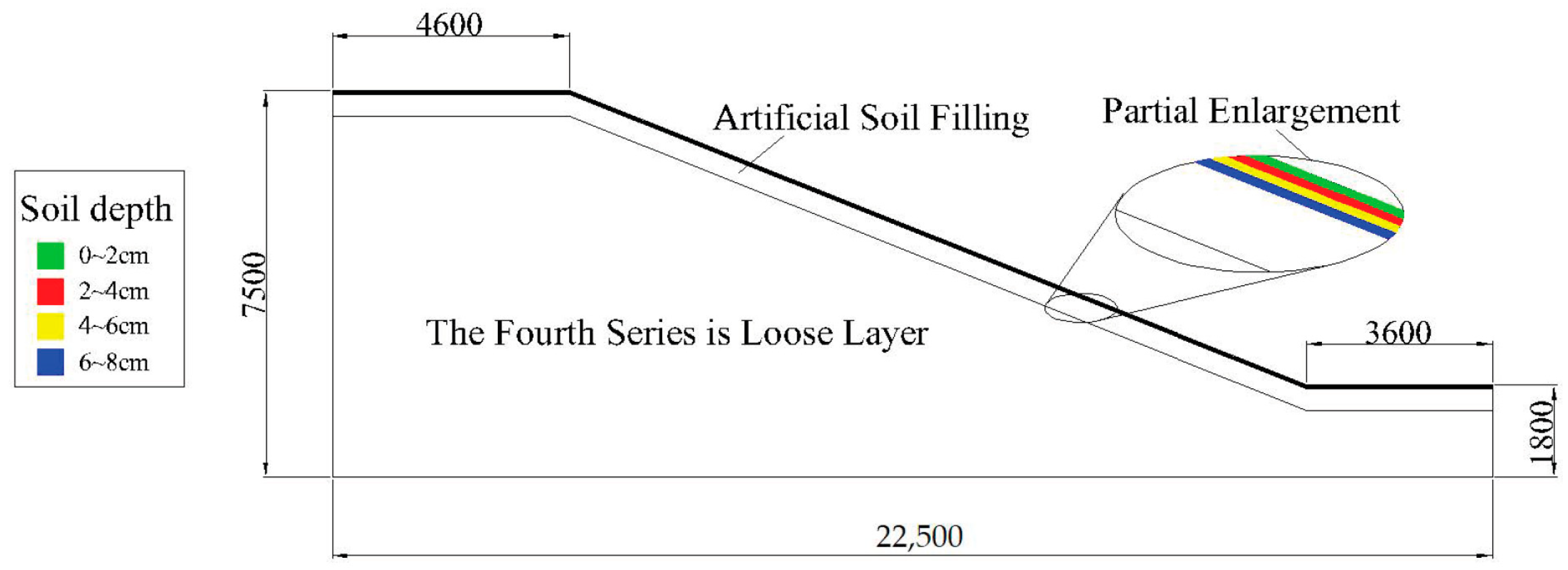Experimental Study on the Effect of Soil Reinforcement and Slip Resistance on Shallow Slopes by Herbaceous Plant Root System
Abstract
:1. Introduction
2. Analysis of Soil Reinforcement and Slip Resistance by Herbaceous Plant Root System
2.1. Mechanical Analysis of Soil Reinforcement by Root System
2.2. Mechanical Analysis of Slip Resistance by Root System
3. Experimental Study on Anti-Shear Performance of Herbaceous Plant Root–Soil Composites
3.1. Overview of the Study Area
3.2. Specimen Preparation
3.3. Direct Shear of Root–Soil Composites
4. Root System Tensile Test of a Herbaceous Plant and Its Additional Cohesion Characteristics
4.1. Root Area Determination Method
4.2. Root System Tensile Test of a Herbaceous Plant
4.3. Relationship between Tensile Strength and Diameter
4.4. Calculation of Root Additional Cohesion and Total Additional Cohesion
5. Numerical Simulation of Shallow Slope Stability under the Effect of a Herbaceous Plant Root System
5.1. Numerical Model Establishment
5.2. Deformation Law of Shallow Soil under the Effect of a Herbaceous Plant Root System
5.3. Influence Pattern of Slope Stability Due to a Herbaceous Plant Root System
6. Discussion
7. Conclusions
- (1)
- For herbaceous plants with a fine root diameter and shallow growth depth, the reinforced soil of a root–soil composite can be divided into a linear superposition of two parts. First, the root–soil composite is regarded as a new material medium, which increases the internal friction angle and cohesion of the original soil and improves the shear strength. The second is the effect of the root force on the soil, that is, the additional shear strength generated by the root tension effect. In this way, a mechanical model of root-modified soil consolidation is proposed, which can be used to evaluate and analyze the root consolidation effect in herbaceous plants.
- (2)
- The root–soil cohesion and shear strength increased with the increase in root content and decreased with the increase in moisture content. The combination of roots and soil significantly improved the plain soil cohesion, and its change was an important index that affected the shear strength of the soil. The improvement of the shear strength of the root–soil composite was mainly reflected in the increase in cohesion, and the internal friction angle had little effect on the shear strength. The tensile strength of the roots increased with the increase in the root diameter and showed a linear relationship. The root–soil composite’s tensile strength decreased with the increase in diameter, showing an exponential relationship. The root area ratio decreased with the increase in soil depth and showed a quadratic relationship with soil depth. The additional cohesion of roots decreased with the increase in soil depth. Under the 9, 11, and 13% moisture contents, the total additional cohesion decreased with the increase in moisture content and increased with the increase in root content.
- (3)
- The total displacement of the root–soil composite layer of the slope decreased with the increase in the root ratio. The slope stability increased with the increase in the root content and generally decreased with the increase in water content. Herbaceous vegetation on the slope could effectively control the slip of shallow soil and improve the overall stability of the slope. This has certain reference significance for the prediction of soil erosion and slope stability in the shallow slope of the mining area and has good application value.
Author Contributions
Funding
Institutional Review Board Statement
Informed Consent Statement
Data Availability Statement
Conflicts of Interest
References
- Zhou, Y. Study on mechanism of Soil Rand slope protection technology. China Univ. Geosci. 2010, 5, 1. [Google Scholar]
- Xiao, D.; Bi, Y.; Yu, L. Key Climate Factors in Species Introduction for Ecological Reconstruction of the Dump Site of Shenhua Baorixile Open-pit Mining. J. South China Norm. Univ. 2021, 53, 73–82. [Google Scholar] [CrossRef]
- Endo, T.; Tsuruta, T. The effect of tree roots upon the shearing strength of soil. Tokyo For. Exp. Stn. 1969, 16, 168–179. [Google Scholar]
- Wu, T.H.; Mckinell, W.P.; Swanston, D.N. Strength of tree roots and landslides on Prince of Wales Island, Alaska. Can. Geotech. J. 1979, 16, 19–33. [Google Scholar] [CrossRef]
- Gray, D.H.; Leiser, A.T. Biotechnical Slope Protection and Erosion Control; Van Nostrand Reinhold Company Inc.: New York, NY, USA, 1982. [Google Scholar]
- Pollen, N.; Simon, A. Estimating the mechanical effects of riparian vegetation on streambank stability using a fiber bundle model. Water Resour. Res. 2005, 41, 1–11. [Google Scholar] [CrossRef]
- Schwarz, M.; Cohen, D. Spatial characterization of root reinforcement at stand scale: Theory and case study. Geomorphology 2012, 171–172, 190–200. [Google Scholar] [CrossRef]
- Liu, X.; Hao, G.; Yu, B. Distribution characteristics of two kinds of plant roots and their effects on surface reinforcement of Open-pit mine slope. J. Yangtze River Sci. Res. Inst. 2022, 39, 96–101. [Google Scholar] [CrossRef]
- Ji, L.; Yin, P. Influence of different root growth stages on the slope anti-erosion performance. J. Cent. South Univ. For. Technol. 2020, 40, 144–150,178. [Google Scholar]
- Ji, X.L. Numerical simulation of root distribution on the slope protection. China Sci. 2020, 15, 652–656. [Google Scholar]
- Wu, M.; Zhou, C.; Wang, L. Numerical simulation of the influence of roots and fissures on hydraulic and mechanical characteristics of the soil. Rock Soil Mech. 2019, 40, 519–526+534. [Google Scholar] [CrossRef]
- Wang, Y.; Wu, M.; Zhou, C. Direct shear test and numerical simulation of combined root reinforcement of slope soil. J. Geotech. Eng. 2020, 42, 177–182. [Google Scholar] [CrossRef]
- Liu, J. Effect of root system distribution on slope stability. Pearl River 2020, 41, 140–145. [Google Scholar]
- Hu, X.; Brierley, G.; Zhu, H. An Exploratory Analysis of Vegetation Strategies to Reduce Shallow Landslide Activity on Loess Hillslopes, Northeast Qinghai-Tibet Plateau, China. J. Mt. Sci. 2013, 10, 668–686. [Google Scholar] [CrossRef]
- Li, J.; Wang, X.; Jia, H.; Liu, Y.; Zhao, Y.; Shi, C.; Zhang, F. Assessing the soil moisture effects of planted vegetation on slope stability in shallow landslide-prone areas. J. Soils Sediments 2021, 21, 2551–2565. [Google Scholar] [CrossRef]
- Dumlao, M.R.; Ramananarivo, S.; Goyal, V.; DeJong, J.T.; Waller, J.; Silk, W.K. The role of root development of Avena fatua in conferring soil strength. Am. J. Bot. 2015, 102, 1050–1060. [Google Scholar] [CrossRef] [PubMed]
- Wang, B.; Wang, S. Shear Strength Analysis and Slope Stability Study of Straight Root Herbaceous Root Soil Composite. Appl. Sci. 2023, 13, 12632. [Google Scholar] [CrossRef]
- Liu, S.; Li, J.; Ji, X.; Fang, Y. Influence of root distribution patterns on soil dynamic characteristics. Sci. Rep. 2022, 12, 13448. [Google Scholar] [CrossRef] [PubMed]
- Cao, T.; Zhang, H.; Chen, T.; Yang, C.; Wang, J.; Guo, Z.; Sun, X. Research on the mechanism of plant root protection for soil slope stability. PLoS ONE 2023, 18, e0293661. [Google Scholar] [CrossRef] [PubMed]
- Löbmann, M.T.; Geitner, C.; Wellstein, C.; Zerbe, S. The influence of herbaceous vegetation on slope stability—A review. Earth-Sci. Rev. 2020, 209, 103328. [Google Scholar] [CrossRef]
- Ding, H.; Xue, L.; Liu, H.; Li, L.; Wang, H.; Zhai, M. Influence of Root Volume, Plant Spacing, and Planting Pattern of Tap-like Tree Root System on Slope Protection Effect. Forests 2022, 13, 1925. [Google Scholar] [CrossRef]
- Li, J.; Wang, X.; Jia, H.; Liu, Y.; Zhao, Y.; Shi, C.; Zhang, F. Effect of herbaceous plant root density on slope stability in a shallow landslide-prone area. Nat. Hazards 2022, 112, 2337–2360. [Google Scholar] [CrossRef]
- Fan, C.C.; Laiy, F. Influence of the spatial layout of vegetation on the stability of slopes. Plant Soil 2014, 377, 83–95. [Google Scholar] [CrossRef]
- Qu, W.; Ji, J.; Chen, L.; Hu, Y. Research on model and test of reinforcing shear strength by vegetation roots in the Loess Plateau of northern China. J. Beijing For. Univ. 2017, 39, 79–87. [Google Scholar] [CrossRef]
- Zhu, J.; Wang, Y.; Wang, Y. An analysis of soil physical enhancement effects of root systems of Pinus tabuliformis and Acer truncatum based on two models. Bull. Soil Water Conserv. 2015, 35, 277–282. [Google Scholar]
- Duan, Q.; Wang, J.; Yang, Y. Improvement of soil shear strength by roots of native herbaceous plants in the dry and hot valley of the Jinsha River and its model prediction. Bull. Soil Water Conserv. 2017, 15, 87–95. [Google Scholar]
- Zhang, J. Research on Comprehensive Benefit Evaluation of Geological Environment Treatment Project in Haizhou Open-Pit Mine; Liaoning Technical University: Fuxin, China, 2022. [Google Scholar]
- GB/T 50123-2019; Standard for Soil Test Methods of the Ministry of Housing and Urban Rural Development of the People’s Republic of China. China Planning Press: Beijing, China, 2019.
- Wang, H.; Xue, L.; Ding, H. Analysis of mechanical properties of Elsholtzia root in the small watershed of Reshui River. Sci. Technol. Eng. 2022, 22, 6894–6903. [Google Scholar]
- Hao, G. Study on the Influence of Herbs in Different Growth Periods on the Stability of Shallow Slopes; Liaoning Technical University: Fuxin, China, 2022. [Google Scholar]
- Liu, Y.; Zhao, Y.; Yang, Y.; Zhang, L.; Liu, W.; Xiong, S.; Duan, Q. Effects of roots of two mixed sowing herbaceous plants on soil shear strength. Sci. Soil Water Conserv. 2021, 19, 81–88. [Google Scholar] [CrossRef]
- Ouyang, J. Study on the Mechanical Effect of Vegetation Roots on Soil Consolidation in Ecological Restoration of Abandoned Rare Earth Mines; Jiangxi University of Science and Technology: Ganzhou, China, 2022. [Google Scholar]
- Mahannopkul, K.; Jotisankasa, A. Influences of root concentration and suction on Chrysopogon zizanioides reinforcement of soil. Soils Found. 2019, 59, 500–516. [Google Scholar] [CrossRef]
- Ji, J.; Zhang, C.; Gao, Y.; Kodikara, J. Reliability-based design for geotechnical engineering: Inverse form approach for practice. Comput. Geotech. 2019, 111, 22–29. [Google Scholar] [CrossRef]
- Ji, J.; Zhang, W.; Zhang, F.; Gao, Y.; Lü, Q. Reliability analysis on permanent displacement of earth slopes using the simplified Bishop method. Comput. Geotech. 2020, 117, 103286. [Google Scholar] [CrossRef]
- Ji, J.; Wang, C.-W.; Gao, Y.; Zhang, L. Probabilistic investigation of the seismic displacement of earth slopes under stochastic ground motion: A rotational sliding block analysis. Can. Geotech. J. 2021, 58, 952–968. [Google Scholar] [CrossRef]










| Soil Depth (cm) | Average Root Content (%) |
|---|---|
| 0~2 | 0.373 |
| 2~4 | 0.289 |
| 4~6 | 0.193 |
| 6~8 | 0.097 |
| Type | Moisture Content (%) | Rooting Rate (%) | Root Growth Depth (cm) | Fitting Equation | R2 | Internal Friction Angle (°) | Cohesion (kPa) |
|---|---|---|---|---|---|---|---|
| Pure soil | 9 | 0 | 0 | 0.98331 | 24.77 | 22.8 | |
| 11 | 0 | 0 | 0.96705 | 22.14 | 42.6 | ||
| 13 | 0 | 0 | 0.98870 | 20.78 | 36.0 | ||
| Setaria viridis | 9 | 0.1 | 6~8 | 0.9938 | 21.42 | 48.0 | |
| 0.2 | 4~6 | 0.9454 | 21.11 | 57.5 | |||
| 0.3 | 2~4 | 0.94175 | 21.02 | 59.1 | |||
| 0.4 | 0~2 | 0.94282 | 21.86 | 60.1 | |||
| 11 | 0.1 | 6~8 | 0.99295 | 21.12 | 43.2 | ||
| 0.2 | 4~6 | 0.98171 | 21.46 | 44.7 | |||
| 0.3 | 2~4 | 0.99851 | 23.35 | 44.1 | |||
| 0.4 | 0~2 | 0.99441 | 23.52 | 46.5 | |||
| 13 | 0.1 | 6~8 | 0.99699 | 20.82 | 38.6 | ||
| 0.2 | 4~6 | 0.99996 | 23.09 | 36.3 | |||
| 0.3 | 2~4 | 0.99978 | 23.20 | 37.1 | |||
| 0.4 | 0~2 | 0.99981 | 23.06 | 41.0 |
| Soil Depth (cm) | Root Area Ratio (10−4) |
|---|---|
| 0~2 | 3.5 |
| 2~4 | 2.3 |
| 4~6 | 0.9 |
| 6~8 | 0 |
| Moisture Content (%) | Depth (cm) | Root Content (%) | Additional Cohesion of Composite Materials (kPa) | Additional Root Cohesion (kPa) | Total Additional Cohesion (kPa) |
|---|---|---|---|---|---|
| 9 | 0~2 | 0.4 | 37 | 5.07 | 42.07 |
| 9 | 2~4 | 0.3 | 36.43 | 3.33 | 39.76 |
| 9 | 4~6 | 0.2 | 34.02 | 1.3 | 35.32 |
| 9 | 6~8 | 0.1 | 23.98 | 0.29 | 24.27 |
| 9 | >8 | 0 | 0 | 0 | 0 |
| 11 | 0~2 | 0.4 | 3.42 | 5.07 | 8.49 |
| 11 | 2~4 | 0.3 | 2.49 | 3.33 | 5.82 |
| 11 | 4~6 | 0.2 | 1.56 | 1.3 | 2.86 |
| 11 | 6~8 | 0.1 | 0.63 | 0.29 | 0.92 |
| 11 | >8 | 0 | 0 | 0 | 0 |
| 13 | 0~2 | 0.4 | 4.99 | 5.07 | 9.97 |
| 13 | 2~4 | 0.3 | 1.05 | 3.33 | 4.38 |
| 13 | 4~6 | 0.2 | 0.26 | 1.3 | 1.56 |
| 13 | 6~8 | 0.1 | 2.62 | 0.29 | 2.91 |
| 13 | >8 | 0 | 0 | 0 | 0 |
| Density (kg/m3) | Bulk Modulus (MPa) | Shear Modulus (MPa) | Poisson’s Ratio (-) | Cohesion (kPa) | Angle of Internal Friction (°) |
|---|---|---|---|---|---|
| 1410 | 2.22 | 1.67 | 0.2 | 10.5 | 20 |
| Scheme | Soil Depth (cm) | Root Content (%) | Moisture Content (%) | Total Cohesion (kPa) | Total Internal Friction Angle (°) |
|---|---|---|---|---|---|
| Scheme 1 | 0~2 | 0 | 0 | 10.5 | 20 |
| 2~4 | 0 | 10.5 | 20 | ||
| 4~6 | 0 | 10.5 | 20 | ||
| 6~8 | 0 | 10.5 | 20 | ||
| Scheme 2 | 0~2 | 0.4 | 9 | 54.54 | 17.05 |
| 2~4 | 0.3 | 48.75 | 16.35 | ||
| 4~6 | 0.2 | 42.97 | 16.23 | ||
| 6~8 | 0.1 | 37.18 | 16.69 | ||
| Scheme 3 | 0~2 | 0.4 | 11 | 18.87 | 21.59 |
| 2~4 | 0.3 | 16.31 | 20.68 | ||
| 4~6 | 0.2 | 13.74 | 19.77 | ||
| 6~8 | 0.1 | 11.17 | 18.86 | ||
| Scheme 4 | 0~2 | 0.4 | 13 | 20.54 | 22.35 |
| 2~4 | 0.3 | 14.67 | 22.35 | ||
| 4~6 | 0.2 | 12.27 | 22.34 | ||
| 6~8 | 0.1 | 13.34 | 21.38 |
Disclaimer/Publisher’s Note: The statements, opinions and data contained in all publications are solely those of the individual author(s) and contributor(s) and not of MDPI and/or the editor(s). MDPI and/or the editor(s) disclaim responsibility for any injury to people or property resulting from any ideas, methods, instructions or products referred to in the content. |
© 2024 by the authors. Licensee MDPI, Basel, Switzerland. This article is an open access article distributed under the terms and conditions of the Creative Commons Attribution (CC BY) license (https://creativecommons.org/licenses/by/4.0/).
Share and Cite
Lv, J.; Wang, W.; Dai, T.; Liu, B.; Liu, G. Experimental Study on the Effect of Soil Reinforcement and Slip Resistance on Shallow Slopes by Herbaceous Plant Root System. Sustainability 2024, 16, 3475. https://doi.org/10.3390/su16083475
Lv J, Wang W, Dai T, Liu B, Liu G. Experimental Study on the Effect of Soil Reinforcement and Slip Resistance on Shallow Slopes by Herbaceous Plant Root System. Sustainability. 2024; 16(8):3475. https://doi.org/10.3390/su16083475
Chicago/Turabian StyleLv, Jinguo, Wenqi Wang, Te Dai, Baoyong Liu, and Guangwei Liu. 2024. "Experimental Study on the Effect of Soil Reinforcement and Slip Resistance on Shallow Slopes by Herbaceous Plant Root System" Sustainability 16, no. 8: 3475. https://doi.org/10.3390/su16083475





